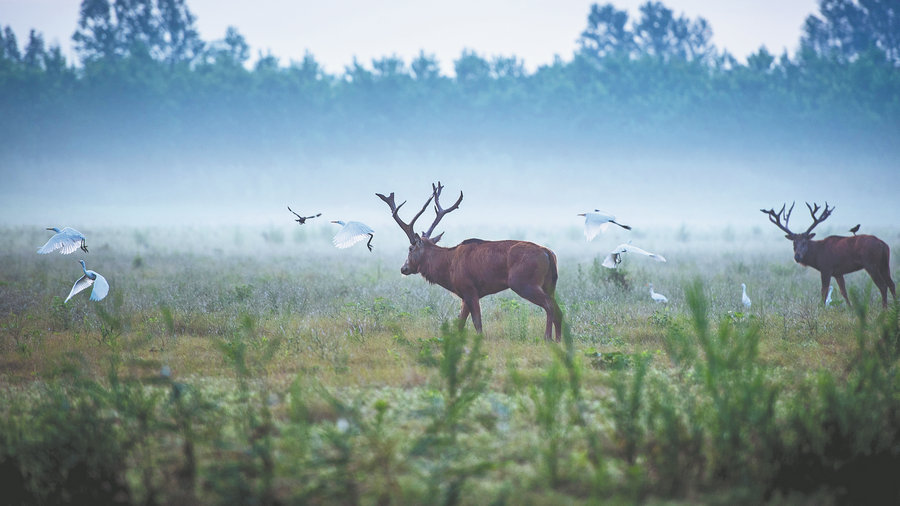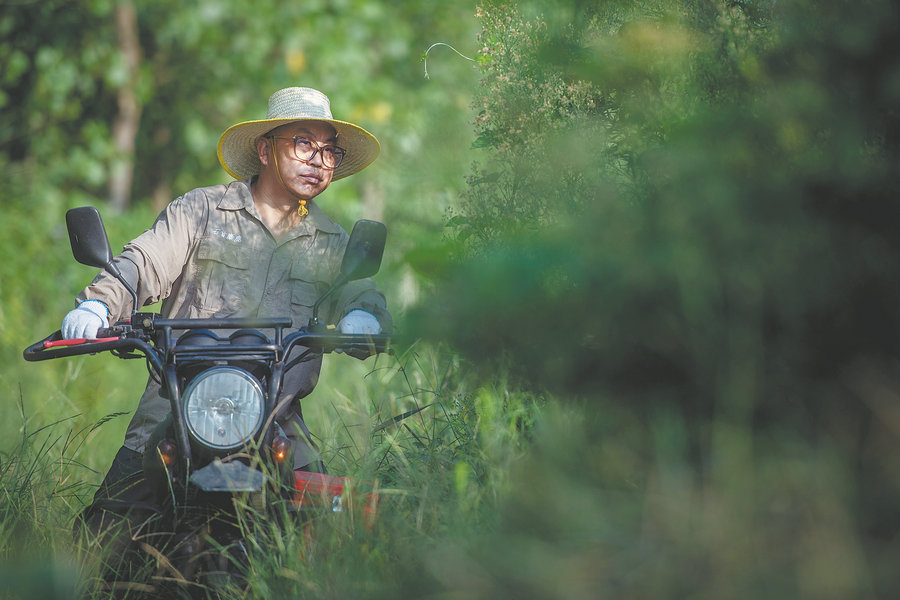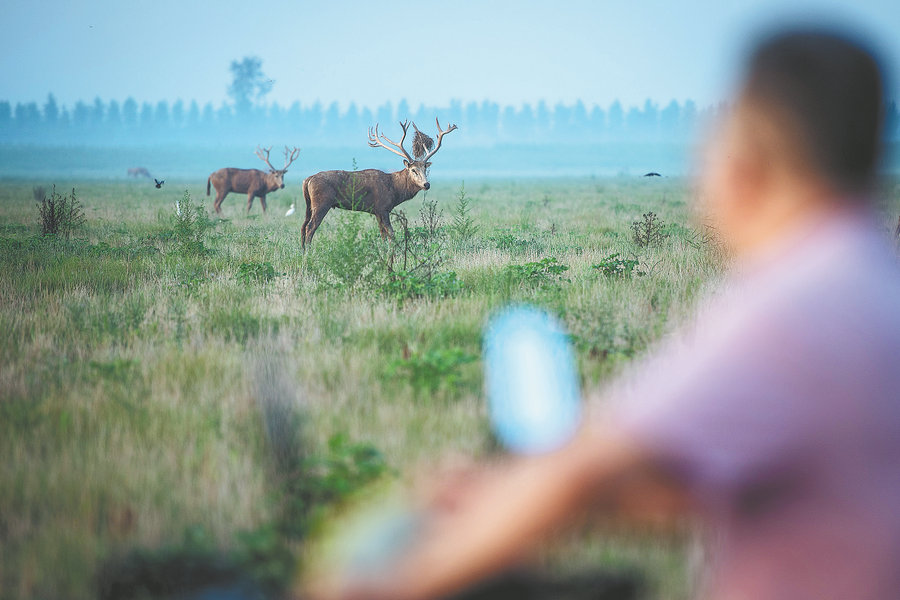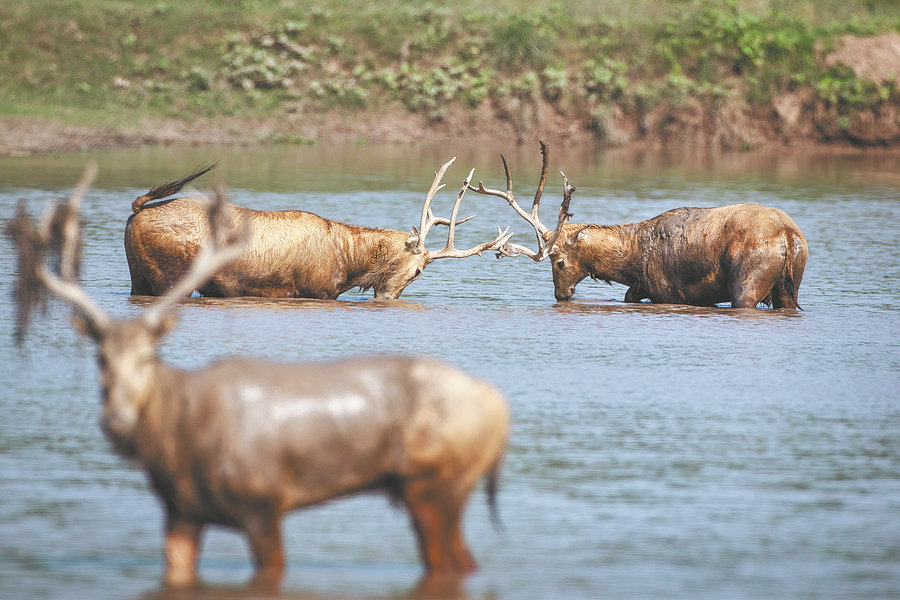Saving deer breeds a story of success

Thanks to decades of conservation, the population of milu deer, a once endangered species, has gradually increased at the Shishou Milu Deer National Nature Reserve. [Photo/Xinhua]
At the Shishou Milu Deer National Nature Reserve in Central China's Hubei province, about 2,000 creatures roam and frolic freely. Their numbers include 460 fawns born this year, evidence that the species, once dying out in China in the early 20th century, have staged a remarkable recovery.
Often referred to as sibuxiang (literally meaning "four aspects seen in other animals") they seem to consist of parts of various creatures. Also known as Pere David's deer, the milu, of course, has antlers like other deer, but also seems to have the head of a horse, the hoofs of cattle and the tail of a donkey.
Its conservation story provides an extraordinary example for other endangered animals under a threat of extinction.
In 1985, the species was reintroduced from the United Kingdom to China, and the population gradually increased.

Ranger Wang Chuanjun patrols at the Shishou Milu Deer National Nature Reserve in Central China's Hubei province during mating season. [Photo/Xinhua]
As one of the animal's three major protected areas in China, the Shishou reserve was established in 1991 with the first 64 milu deer introduced from Beijing two years later.
Close to the Yangtze River, the area has a complete wetland ecosystem and a vast pasture, an ideal habitat for the deer.
This year marks the 30th anniversary since their introduction and thanks to the past decades' efforts, the number of milu is about to reach the upper limit of the reserve's capacity.
In January, an additional extended area of the reserve, covering 8,000 mu (533.33 hectares), initially opened its doors to its first 400 milu.

Yang Tao, the reserve's deputy director of management and scientific research, tests a supervision platform that automatically collects data and provides warnings, intelligent monitoring and analysis. [Photo/Xinhua]
"So far, we have observed more than 10 naturally formed breeding groups of varying sizes among the milu deer," says Zhang Yuming, a 45-year-old engineer who has been monitoring and caring for milu at the reserve for the past 12 years.
He adds that more fawns are expected to be born this year.
At the reserve in Jingzhou, Hubei, milu deer usually mate between June and August, during which the males fight each other for the privilege to stay with as many females as they wish. To ensure a safe and tranquil environment for reproduction, a team of two engineers and eight rangers have increased patrols of the reserve.
At the same time, advanced technologies, such as drones, infrared cameras, intelligent monitoring, have been applied at the reserve to help observe and analyze the milu's habits, routines and environment.

Wang checks to see if any milu are sick, if the barrier netting is damaged or if any person or domestic animal from outside has tried to enter the reserve. [Photo/Xinhua]
Yang Tao, the reserve's deputy director of management and scientific research, says the environment and dedicated efforts of those responsible for the deer has resulted in the massive increase in numbers.
In the country's three major protected areas — the Nanhaizi Milu Deer Park in Beijing, the Dafeng Milu Deer National Nature Reserve in Jiangsu province, and the Shishou reserve — the animal's population has increased significantly from just 39 in 1986 to over 10,000 now.

Engineer Zhang Yuming takes photos of milu deer. He has been monitoring and caring for milu at the reserve for 12 years. [Photo/Xinhua]

Technician Ge Xianmei uses a remote controller to manipulate a drone to observe the milu. [Photo/Xinhua]

The deer fight using deadly antlers at the reserve. [Photo/Xinhua]
Related articles
-
 Chagan Lake Winter Fishing: A Millennium-Old Tradition
Chagan Lake Winter Fishing: A Millennium-Old TraditionMore
-
 Making the cut: Prints by prominent woodblock artists on show in Beijing
Making the cut: Prints by prominent woodblock artists on show in BeijingMore
-
 Snuff bottles displayed at Ningxia Museum in Yinchuan
Snuff bottles displayed at Ningxia Museum in YinchuanMore
-
 Uncovering the rich cultural heritage and history in Gansu
Uncovering the rich cultural heritage and history in GansuMore
-
 Saving deer breeds a story of success
Saving deer breeds a story of successMore
-
 CSG and CFRD jointly organized ‘My Writing Can Sing - 2023 Zhixing Children's Reading Festival’
CSG and CFRD jointly organized ‘My Writing Can Sing - 2023 Zhixing Children's Reading Festival’More
